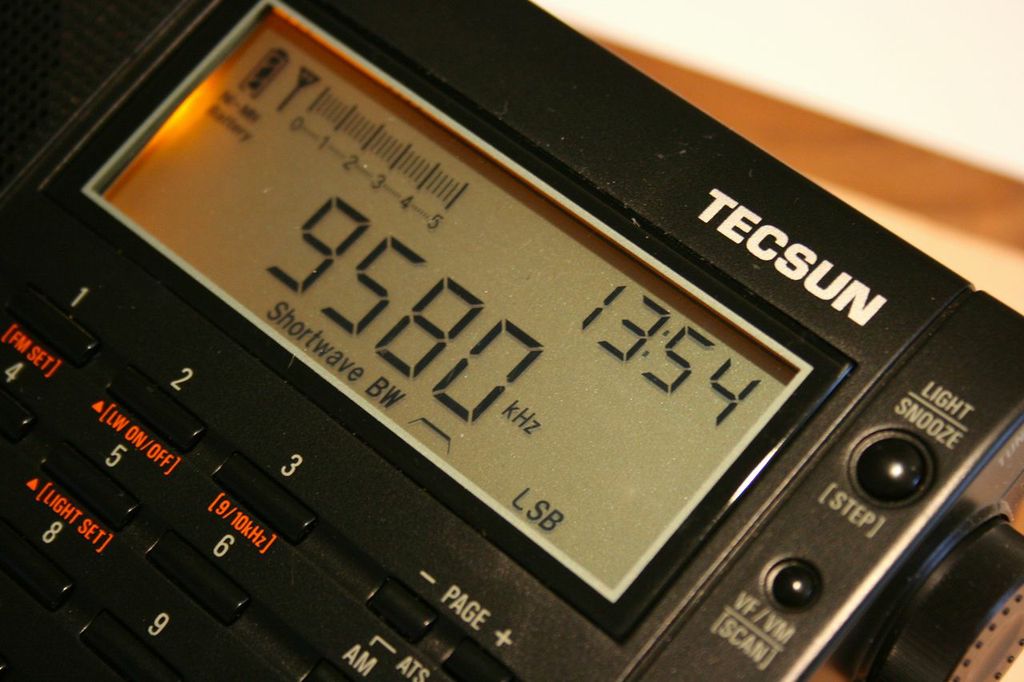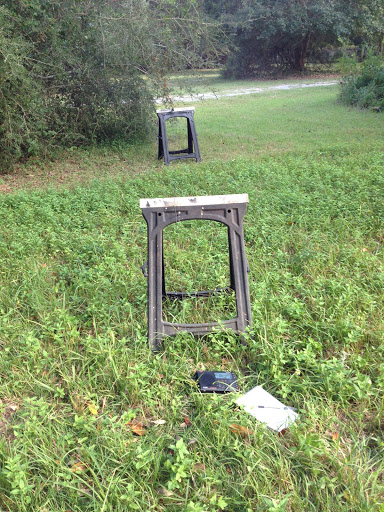 Many thanks to SWLing Post contributor, Rob Zingarelli, who shares the following guest post that originally appeared on his blog in October, 2020:
Many thanks to SWLing Post contributor, Rob Zingarelli, who shares the following guest post that originally appeared on his blog in October, 2020:
Shortwave Antenna: Vertical or Horizontal?
by Rob Zingarelli
This is a question that has circled around on the fringes of my consciousness for years now, but one that I’ve never quite found time to test. And it is a simple question: When using a random wire antenna with a portable shortwave receiver, is it better to string the wire vertically or horizontally, or does it even matter? Mostly this is a question when out camping, because arranging a 19′ wire vertically is usually a good bit more involved than just stringing it out along some nearby bushes.
Before going any farther, I want to point out that this is an exercise in ordinary backyard shortwave listening with relatively inexpensive equipment. There are many, many better-engineered and more costly solutions to the technical challenge of shortwave scanning, and this does not address any of those sophisticated approaches. This is for the person who opens up the box and wonders about the best way to hang the included long-wire auxiliary antenna.
Equipment: Tecsun PL-660 SW/AM/FM/Air Band receiver, with its included 19′ random-wire antenna. Internal battery power used.
Conditions & Time: Clear local weather. hamqsl.com’s nowcast of band conditions were fair from 3.5-14.35 MHz, and poor for higher frequencies, with SFI = 72, SN = 26, A = 5, K = 1. Time was 21:00-21:30 UTC, or 4-4:30 pm local CDT.
Procedure: Out in the backyard (typical residential neighborhood, well-spaced ~150′ between houses, above-ground power lines 125′ away), suspend random wire from ground to its full length. This was achieved using a length of paracord over a tree limb, with the tree trunk ~30′ from the radio’s location. With the PL-660’s antenna gain control set to “Normal” (i.e., the mid-setting of Local-Normal-DX) and the bandwidth set to narrow, use the receiver’s automatic scan function to see how many stations were received. Make notes of the number of transmissions detected, reception characteristics and quality, and any perceived noise levels. Re-orient the antenna to a low horizontal position, over two sawhorses approximately 3′ high (see picture), and repeat.
Results: For the vertical antenna orientation, 32 stations were detected between 5959 – 15730 kHz. Nearly all were intelligible, with those at the lower end more steady and those a the higher end much more variable in strength. For the horizontal antenna orientation, 21 stations were detected between 9265 – 1570 kHz. Similar overall signal quality was heard for the received stations in either antenna orientation. More noise was noticeable at the lower frequencies between the stations for the vertical antenna orientation. However, this was significantly below the received signal levels, and not an issue in the overall listening quality.
Conclusions & Discussion: Suspending the wire antenna vertically worked better, especially at the lower frequencies. Getting a wire up 21’+ vertically is usually not as convenient as stringing it horizontally, but it may be worth the extra effort, depending on the location, campsite, nearby trees, etc. The overall conditions were typical for fall camping weather, with fair-to poor radio propagation conditions, so this result should be broadly applicable for how SW portables are often used. This result may change with propagation and radio noise conditions, both for atmospheric and local noise sources. Testing will continue as propagation conditions improve with solar cycle 25 getting underway.
——-
Addendum, 10/12/20: While writing this up yesterday evening, it occurred to me that I hadn’t tested the PL-660’s built-in whip antenna. This comparison is important, because sometimes the wire antenna is too cumbersome to deploy. So, how does the whip antenna compare?
Conditions & Time: Overall, very similar to yesterday. hamqsl.com reports fair conditions from 3.5–14.35 MHz, and poor for higher frequencies. SFI = 72, SN = 26, A = 3, K = 1. Same time of day as yesterday’s testing.
Procedure: Repeat of yesterday, with the whip antenna added to the test. The whip was oriented vertically.
Results: For the vertical 19′ wire, 31 stations were found by the auto-scan function between 2380 – 15770 kHZ. Electrical noise was low but audible in the 3 MHz region, fading to none at higher frequencies, and not a significant source of interference with any stations. For the horizontal wire, 15 stations were found between 9265 – 13630 kHz. Electrical noise was barely audible. With the whip in use only 1 station was found. Switching the antenna gain to its DX (most sensitive) setting, 6 stations were found.
Revised Conclusions: Adding to yesterday’s conclusions, the whip antenna functioned but was vastly inferior to the wire antenna in either configuration, even with the gain set to DX. Today’s results with the wire antenna were, unsurprisingly, very similar to yesterday’s, given that the ionospheric and weather conditions were nearly identical. Noise was not a factor in receiving for any of these antennas or configurations, but did noticeably increase for the vertical wire antenna.
Thank you for sharing this, Rob! It’s experiments like this that help us determine, especially, what antenna setups work at our own particular locations since RFI characteristics can vary so much. I’m guessing had your horizontal wire been elevated to even 20′ off the ground it might have produced better results, but sometimes this can be difficult to achieve. I like how you used the auto search function to determine the number of stations you could receive with each setup and it was a great addition to include the built-in telescoping whip.
Thank you again for sharing your results with us!


Rob, this is John Harris, computer guy from FSU Nuclear Research.
I’m not a SWL sort of person, but I would say that a vertical antenna would be vertically polarized and a horizontal antenna would be horizontally polarized. There is circularly polarized as well. It would depend upon the polarization of the antenna at the far end.
I did some limited experiments with antenna polarization using WiFi. Left and right circular polarization is pretty much receivables unless the polarization of the sending antenna matches.
Nice testing and great findings. I was wondering the same, because I want to set up a 60′ vertical antenna, and found here at least the empirically obtained answer for the RX part. Thanks and 73 de CA3TSK.
Oh, there are many refinements that can be made here, but as I said at the start, “This is for the person who opens up the box and wonders about the best way to hang the included long-wire auxiliary antenna.” For 99% percent of new SWLers, especially those with kids, the perfect is the enemy of the good. The post here is about answering a common question: if you can, hang the included wire vertically.
In reference to “W1PJE’s” comments about using a beverage antenna. One has to take into consideration that using such an antenna on a Tecsun PL-660 or similar receivers ‘may’ cause overload. The Tecsun PL-660 even with it’s attenuation controls, (in my opinion) is best used with a random length of wire no more than 20-25 feet in length. The PL-660 & similar are manufactured to be very sensitive & thus the front end transistor(s), etc. may have to be replaced. Also the longer the antenna, the greater the possibility of static precipitation from wind, snow etc. which could wreck havoc on the portable radios. Most hams/swl’ers who use beverages are using tabletop receivers with significant safety features to minimize any of the above problems. Please note that i am not a radio/antenna professional & thus just giving my two cents worth. :>)
For a radio amateur, this result is no surprise because of the “ground effect”: For a horizontal antenna, much of the energy is reflected on the ground. If the antenna is much less than a half wavelength above ground, the radiation from the antenna and from the ground add in a way that hardly energy is radiated along the ground. A vertical antenna suffers much less from this effect.
Many radio amateurs use horizontal antennas for the lower bands, like 80m, for distances up to about 1000 km. On the higher bands like 20m, where large distances can be bridged much more easily, many radio amateurs use groundplane antennas, vertical dipoles and comparable designs.
Hi Rob, thanks for the test, just let me make some notes
While it isn’t a beam, an horizontal wire antenna shows some directional pattern, so when comparing it with a vertical (which is omnidirectional), it’s no surprise getting a lower number of stations, since a number of those may be toward a direction where the wire is “deaf”, I believe that a better test would be changing the horizontal antenna orientation by (say) 90 degrees and then checking if the stations received are the same or not, also, since you seem interested in experimenting with simple antennas, you may consider the idea of getting a fishing rod, that won’t just allow you to easily put up the antenna in vertical configuration. but also to test it in “inverted L” one, in such a case the wire will go up to the top of the rod and then run sideways to some support (e.g. a tree or whatever), I believe that such a config may be interesting to experiment ;-D
Highly recommend reading about Beverage antennas, in use since the 1920s, for low to the ground horizontal single wire antennas. One of your tests was essentially a Beverage but without the key elements: matching transformers for impedance adjustment and a termination resistor at the end. Beverages are highly effective and will vastly improve the S/N ratio – with the caveat that they are very long (1/2 to several wavelengths long, so in e.g. the 49 meter shortwave band, you are talking about lengths >= 80 feet).
See
https://en.wikipedia.org/wiki/Beverage_antenna
and
https://www.dxengineering.com/parts/dxe-bfs-1